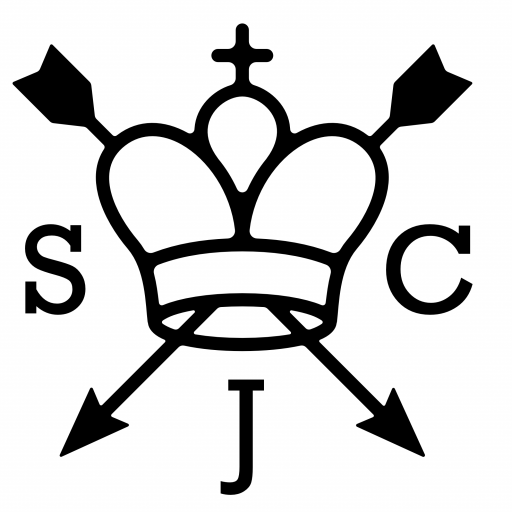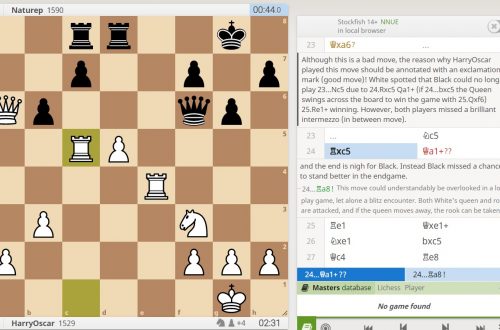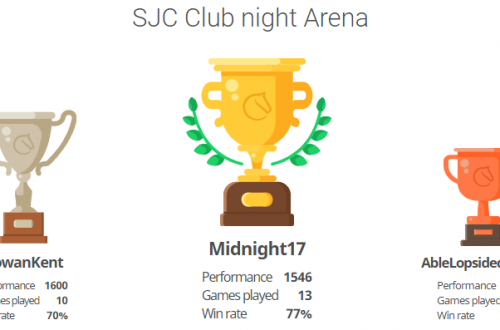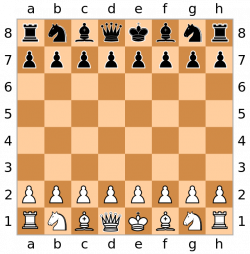
Chess notation
What is Chess Notation and why is it used?
Chess notation is the method by which chess games are recorded. Chess games are often recorded in chess tournaments – the sort of tournaments which are played in school halls and other venues. Games are recorded for the following reasons:
- Simply to keep a record of the game so that the player can go through the game afterwards and look for how they could have played better.
- Good practise – it is a good idea for young players to record their games as it helps them to focus better and also helps slow them down. Often, players first “in the flesh” tournaments are 30 minute games – so the players get 30 minutes each on the clock. Often these games can finish in a total of 10 minutes – so the players don’t use their time and don’t look for the best moves – they play the first OK move they see. By recording the games, it slows them down and they think about the game better.
- Games are sometimes recorded so that the games can be published and others can look through the games.
- Tournament rules – at some events it is a requirement that the games are recorded.
- And – unfortunately – because of cheating. Very rarely, players do cheat. One example I can remember happening is as follows: one player won by Checkmate, the opponent then moved a piece and claimed that this was the genuine position and insisted it was not Checkmate. At chess tournaments there are always Arbiters who are there in part to resolve disputes. On this occasion, fortunately, the Suffolk Junior Chess player who had won the game fair and square was able to prove what the position was because she had recorded the game.
Fortunately cheating is very rare, and as you can see above, there are plenty of good reasons to record games.
So, how are games recorded?
Each piece has a code – as follows:
K: King
Q: Queen
B: Bishop
N: Knight
R: Rook
Pawns – pawns do not get a letter – as you will see.
Notice that the letter that denotes a piece is always a CAPITAL letter.
Each square on the board has a code. Each horizontal row of squares – these are called “Ranks” – has a number from 1 to 8. Each vertical column of of squares – these are called “Files” – has a letter – and these run from “a” through to “h“. So a square may be known as, for example h8. When noting a square on the board, the letter is always a small letter.
The chess notation then records each move in turn. You write down the piece being moved first and then the square to which that piece is being moved to. An example of this is “Qh8“. So, this simply means that the Queen (Q) is moved to the square h8.
If when a piece is moved, one of the opponents pieces is taken, this is mark with an “x“. An example of this would be “Qxh8“. So, the Queen “takes” – x – whatever of the opponents pieces is located on the h8 square.
So, how do you record putting the King into check? – answer – “+“. An example of this is “Qh8+“. So, the Queen moves to the h8 square and puts the opposition King into Check.
Checkmate? – “#” – an example of this is “Qh8#“, which means that the Queen moves to the h8 square and puts the King into Checkmate. Another example may be “Qxh8#” – which means that the Queen takes a piece on h8 and puts the King into Checkmate.
There is sometimes a problem that two pieces could both move to the same square. An example of this may be where two Queen’s, obviously located on different squares can both move to the same square. The solution is to record something about the square from which the Queen was moved. For example: “Qbh8+“. The Qh8+ element of this is simple – The Queen moves to h8 and puts the King into Check. But, what does the “b” mean? Well, this example is taken from the “Mate in 2” problem below. If you look at the board below, White is lucky enough to have two Queen’s and they can both make the move to h8. However, there is only one Queen on the “b” file, so recording this records which Queen makes the move.
Sometimes, both Queens may be on the same file, but then they will be on a different rank – so you may record “Q8h8“. This means move the Queen located on the 8th rank to h8.
When a pawn is moved, oddly the Pawn is not mentioned – the notation will simply state the square to which the pawn is being moved. If you think about it, if a pawn is moved to a certain square, there is only one pawn that can make that particular move. And there is no need to mention that it is a pawn, if it was another piece, it would note which that piece is, it may say Qh8, for example. An example of a pawn move is as follows: “e4” – this means that a pawn moves to the e4 square. As already mentioned , there can only be one pawn that can complete any particular move in any particular position.
When Pawns take a piece, it is recorded slightly differently. Because the pawns are not uniquely identified, and in some positions there can be two pawns that can take a piece, so we need to identify which pawn completed that move. An example of this is as follows: “dxe5“. This means that the pawn located on the “d” file takes whatever piece is located on the “e5” square.
Then, there is Castling. This is recorded as “0-0” or “0-0-0“. “0-0” means Castling to the Kings side (the nearer side to the King), and “0-0-0” means castling the other way.
Lastly – thankfully – how do you record promoting a piece? – this is when a pawn makes it all the way to the other side. The player whose pawn it is can then exchange the pawn for any other piece. Mostly players exchange pawns for Queen’s, for the obvious reason – she is the most powerful piece – why not have another? Just occasionally it is better to exchange for a Knight, but this is fairly rare. But – how do you record it? An example of this is “e8=Q“. This means: Put the pawn on the “e8” square and exchange the pawn for a Queen.
There are a few other notations which are sometimes used:
“!” means a good move
“!!” means a brilliant move
“?” means a mistake – a bad move
“??” means a blunder – a really bad move that lets your opponent take a piece
“?!” means a dubious move
“!?” means an interesting move
Honestly – I never really look at the exclamation marks and question marks, and these are generally only added after the game, so don’t sorry about them – they are confusing.
I hope the above is clear – I dare say I will read it tomorrow and realise how hard it is to follow, but I thought I would at least attempt to explain chess notation. Alternatively… look at this link: https://www.chess.com/terms/chess-notation
Chess Problem – Checkmate in 2…
The position below is taken a game in the Bullet tournament last Sunday. This is a game between WiseCrabbyCoconut and ZanyHummingBook. Spotting Checkmates can be hard enough, but in Bullet Chess, they are especially hard. In this game, each player started with 3 minutes on the clock, and each turn, were given an extra 3 seconds. The extra three seconds is to help if there is a slow connection. Given that white won with the 57th move, that is pretty a pretty impressive rate of play, given how little time the players had.
In this position White, who is lucky enough to have two Queen’s, finds a way to force Checkmate in two moves. Can you see how? – answer below the puzzle.
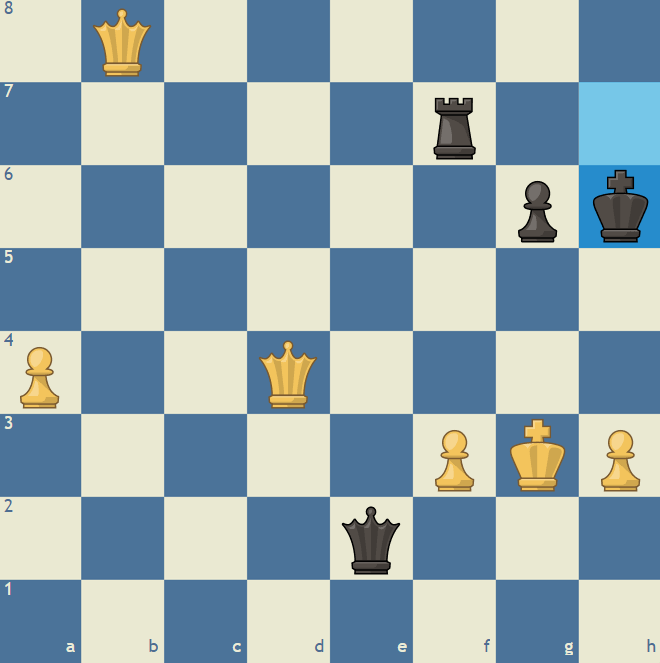
Answer:
Move 56: Qbh8+; Rh7
Move 57: Qh4#
Let’s decode that…
Qbh8+: The Q represents the Queen, and h8 represents the h8 square on the board. So this is saying: “The Queen moves to h8”. So, what does the “b” mean? Well, if you look at the position above, which shows the position on the board before White’s move at Move 56, you will see that both of White’s Queen’s could be moved to h8. So, on this occasion, the “b” means that it is the Queen on the “b” file that is moved. The “+” sign at the end means “check” – so this is a move which puts the opposition into Check.
Rh7: This simply states: “The Rook “R” moves to the square h7″. Actually, in this position, Black has two options, there is another way out of Check, but unfortunately, both options lead to Checkmate on the next move.
Qh4#: The “Qh4” elements of this simply means “The Queen “Q” moves to h4″. And the “#” sign means “Checkmate”.


